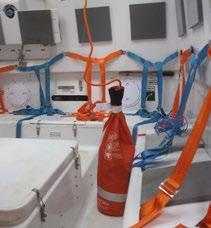
4 minute read
E-OBS/WORKFORCE ENGAGEMENT CHAMPIONS
they deserve. It’s been great getting to engage with the workforce as part of our e-obs journey.
e-obs is continually improving - the monthly e-obs community practice call,increased participation & alignment with operators, contracting companies, supply chain & others utilising the system, it will only get better.
There was no silver bullet to success. A culmination of factors went into engaging with the workforce in making e-obs a sustainable tool for improving our HSE performance, as well as sharing lessons learned.
These factors include:
• Ensuring SI971 ESRs were shown how to use the system so they could support & engage with their constituents in using e-obs
• Utilising safety meetings to set the teams up in e-obs & coaching them in how to use it, whilst also seeing the feedback on their phone/ tablet/ laptop etc.
• Having the on-hand support of the Step Change team to make improvements to the system & help troubleshoot so our data was accurate & simple to analyse
• Being proactive & having the leadership team allow the utilisation of the Brent Visual Onboarding space at Tullos to engage with peers before they got offshore, to give them an insight into using e-Obs.
We believe one stand-out factor that makes e-obs a success is being visible onsite & engaging in open discussions with the boots on the ground about the cards they submitted. Although feedback goes in electronically within 24-48hrs, you often get a high-quality card & we believe that merits taking time out from behind the desk & going to speak to the card initiator & explain what we are going to do to support making positive safety improvements at site.”
Talking of the e-obs system, fellow colleague Paul Parkes said: “The rollout of the new e-obs system has gone relatively smoothly considering the usual pushback you get when new initiatives are introduced (why change, I’m not using my phone for this, I’m no good on computers so I won’t be putting any more observation cards in). This system is only as good as the users, and thanks to the buy-in from the great team on the Brent Charlie, the system is now working to great effect.
The platform is benefiting from the quality of observations being entered, and the way it allows delegation to relevant departments to deal with them in a safe and efficient manner, also allowing visibility from onshore. The monthly calls with Step Change are great as they listen to the platforms that are using the system, are open to improvement opportunities and seek to having them implemented as soon as possible. This is an ever-evolving tool that can only benefit the industry if used to its full potential.”
The Health and Safety Executive (HSE) has been working with the industry to ensure that installations can demonstrate that all personnel can be evacuated in an emergency via Totally Enclosed Motor Propelled Survival Craft (TEMPSC) according to their Emergency Response Plans (ERP) and that the evacuation times stated in their ERP are realistic and achievable in practice.
TEMPSCs are used as an alternative means of evacuation in the event of a major fire and explosion incident, or if the helideck cannot be used due to listing or structural failure during these circumstances.

Regulatory body OEUK has recently published its guidelines on this with peer reviews undertaken by Step Change in Safety and members of OEUK Health & Safety Operators Technical Group and Escape, Evacuation & Rescue Technical Advisory Group (EERTAG).
The recent legislation and guidance include the consideration that many human reactions to an emergency, and other factors, may slow the TEMPSC loading process, which cannot be replicated during a loading exercise.
The action of people in an emergency has been the subject of countless studies and it is foreseeable that people under stress will act differently in an emergency when compared to a training exercise. Duty holders are being asked to ensure that the outcome of the exercise is realistic and reflects the time it may take to evacuate the installation, and where, for example, the timings differ between exercises the duty holder should adopt a pessimistic approach. Duty holders are also being asked to consider the maximum personnel on board (POB) of the installation and ensure this is reflected in the results of the exercise.
Member companies dedicate specialist resources and technical expertise in providing technical notes in collaboration with OEUK, demonstrating a commitment to continually improving and enhancing the performance of all offshore operations.
For further information and to download OEUK’s recent technical note, please visit https://rb.gy/vgsfz1 or scan the QR code:
All personnel who carry out lifting operations; be they crane lifting or portable lifting operations, know that the potential to hurt yourself and others is ever present. However, there still appears to be a misconception in some sections of our industry that lifting operations are “easy, anyone can do them”. While lifting operations will never be rocket science, if you get them wrong you WILL hurt someone. We need to move away from this cavalier attitude and consider our own wellbeing and the wellbeing of others.
The Health and Safety Executive, from their review of lifting incidents, has seen that there is a trend showing more incidents occurring in lifts deemed to be “simple” or “routine”. As humans we will all consider something we have done numerous times without difficulty as being simple and routine, we accept that “it was okay the last time we did it” and neglect to look for new or additional hazards –confirmation bias. Hazards change all the time – environmental hazards such as wind may stop a lifting operation today that was perfectly safe yesterday. Personnel new to the installation or task will need additional supervision. Changes in the worksite such as a new scaffold being erected will introduce new hazards. SIMOPS can change at any time. We need to open our eyes and look for these hazards, and we need to open our mouths and let others know when we spot a new hazard. Never be afraid to ‘Stop the Job’, discuss the new hazard and decide a safe way ahead. Doing this may be the single thing that prevents you or one of your workmates getting hurt. It’s too late when all you can say is “I noticed that but thought it would be ok, so said nothing”.
Kenny Lawtie Wood Head of Lifting / Lifting Technical Authority





